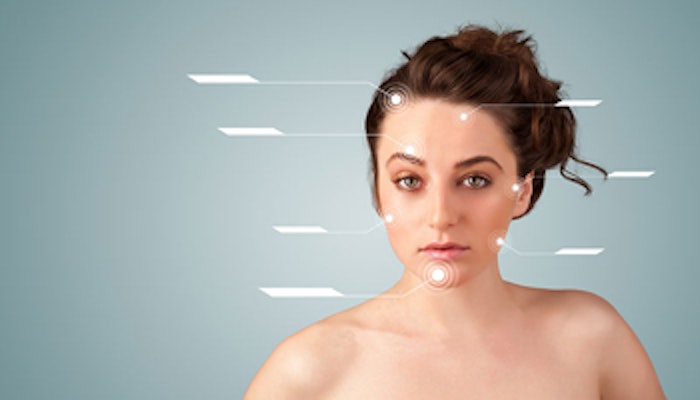
During More Facts, Less Illusions, the IFSCC Conference held in Zurich in September, the organizers called for more scientific publications demonstrating the credibility of our industry rather than basing skincare on marketing dreams and illusions. Advancements in understanding the quality of facial skin in different zones represent one of the exciting areas in skin science. Facial mapping will enable the industry to test real efficacy of newly developed skincare products on the face.
About a third of my adult clients suffer from acne, which is in line with a large global study that reported that 26% of women between the ages of 31 and 40 continue to struggle with facial acne; 12% between ages 41 and 50 fight it. The study found that comedonal acne as opposed to inflammatory lesions, prevails in older age. Women often present at my clinic with adult acne flaring prior to their menstrual cycle.
Sebum production, abnormal proliferation or inadequate desquamation of follicular keratinocytes, androgens, local cytokine production and bacteria are implicated in acne onset. However, the interplay between these factors at different stages and clinical types of acne has not yet been fully understood. Of the factors contributing to acne development, sebum production is known to play a role in acne.
Traditionally, the T-zone is an area with high sebum secretion and the U-zone an area with low sebum. In my experience, the chin area is the most prone to fluctuating facial acne. Recent research has defined the perioral, “the O-zone”, as an area with a moderate to high sebum secretion prone to acne in adults.
My recommendations for an efficacious skincare routine that alleviates acne follow physiological principles. There is an emerging body of evidence suggesting that a clinically successful skincare routine has to incorporate:
- A gentle cleanse
- Sebum-controlling agents to minimize excessive sebum production
- Antimicrobial and anti-inflammatory actives in a specific, light day and night moisturizer
- A keratolytic to reduce keratinisation and further facilitate absorption of actives
What is often surprising is that most of my clients have small patches of comedones and inflamed lesions at the temples, even when most of their facial skin remains clear with compliance and continuous monthly extraction treatments.
Facial mapping of biophysical skin parameters has become an area of increased scientific interest in the past decade. However, only recently has the complexity of facial skin parameters been acknowledged, resulting in the creation of continuous color maps. This sophisticated approach aims to visualize—and interpret—the complexity of patterns in facial skin hydration and barrier properties in different ethnic groups.
Measuring trans-epidermal water loss (TEWL) and skin capacitance on 30 pre-defined sites on the face (particularly the forehead, cheek, jaw and eye areas) enables the generation of continuous color maps by interpolating between each measured value and superimposing these on the digital images of a face. Remarkable skin capacitance and TEWL gradients emerge within short distances on selected areas of the face, distinctive in the different ethnic groups.
Acne-prone skin benefits from increased skin hydration and defective barrier function has been proposed in acne. Functional maps of other biophysical skin parameters, e.g. sebum production, follicular keratinization and the mapping of bacterial flora, etc., are required to understand the different facial zones in detail.
Sebum production itself does not seem to cause acne; more likely the abnormal quantitative and qualitative changes in sebaceous lipids are the cause. These can be a result of aberrant lipid synthesis in the sebaceous gland or post-synthetic modification that includes sebum oxidation. However, reduction in sebum production has been linked to a reduction in acne as shown by a review combining data from studies of various acne treatments; the projected sebum reduction required to achieve a 50% reduction in acne measures ranged from 30 to 50%.
Recently, targeting the individual acne-prone follicules has been of interest. A new approach to suppress the growth of Propionibacterium acnes by manipulating the follicular microenvironment has been proposed. The target is the intra-follicular water; an aqueous component available within colonized follicles—this is suggested to be a major factor determining which follicles can sustain microbial populations. The clinical premenstrual flare of acne in many women might be explained by water retention, decrease in the size of the pore and transient increase in the intra-follicular water content that enables bacterial growth and inflammation.
In absence of these detailed maps, I advocate compliance and diligent skincare, particularly for sebum and comedone removal through cleansing and exfoliation. The importance of skincare, as a component of acne management, is becoming recognized by dermatologists and collaborative working benefits the patient. Optimal approach calls for patient education, evidence-based selection of a combination of therapies (including pharmacological therapy) as well as compliance with the program.
Inadequate skincare may worsen acne. As with any combination of topical formulations, it is key to consider its overall effectiveness, skin tolerability and consumer satisfaction in a “real-use” scenario to provide benefits for acne-prone skin.11-13
REFERENCES
Voegeli R, et al. Facial color mapping of stratum corneum hydration of different ethnic groups and the effect of a moisturizer. 23rd IFSCC Conference, 2015, Zurich.
http://www.ncbi.nlm.nih.gov/pubmed/22171979
http://www.ncbi.nlm.nih.gov/pubmed/23981080
http://www.ncbi.nlm.nih.gov/pubmed/20807258
http://www.ncbi.nlm.nih.gov/pubmed/17577354
http://www.ncbi.nlm.nih.gov/pubmed/26221966
http://www.ncbi.nlm.nih.gov/pubmed/21993702










